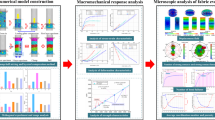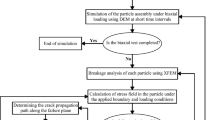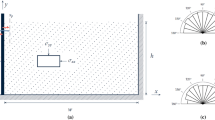Abstract
Retained backfill response to wall movement depends on factors that range from boundary conditions to the geometrical characteristic of individual particles. Hence, mechanical understanding of the problem warrants multi-scale analyses that investigate reciprocal relationships between macro and micro effects. Accordingly, this study attempts a multi-scale examination of failure evolution in cohesionless backfills. Therefore, the transition of retained backfills from at-rest condition to the active state is modeled using the discrete element method (DEM). DEM allows conducting virtual experiments, with which the variation of particle and boundary properties is straightforward. Hence, various modes of wall movement (translation and rotation) toward the active state are modeled using two different backfills with distinct particle shapes (spherical and nonspherical) under varying surcharge. For each model, cumulative rotations of single particles are tracked, and the results are used to analyze the evolution of shear bands and their geometric characteristics. Moreover, dependencies of lateral pressure coefficients and coordination numbers, as respective macro and micro behavior indicators, on particle shape, boundary conditions, and surcharge levels are investigated. Additionally, contact force networks are visually determined, and their influences on pressure distribution and deformation mechanisms are discussed with reference to the associated modes of wall movement and particle shapes.
Similar content being viewed by others
References
Coulomb C A. An attempt to apply the rules of maxima and minima to several problems of stability related to architecture. Memoirs of the Royal Academy of Sciences, 1776, 7: 343–382
Rankine W J M. On the stability of loose earth. Philosophical Transactions of the Royal Society of London, 1857, 147: 9–27
Terzaghi K. A fundamental fallacy in earth pressure computations. Boston Society of Civil Engineers Journal, 1936, 23(2): 71–88
Tsagareli Z V. Experimental investigation of the pressure of a loose medium on retaining walls with a vertical back face and horizontal backfill surface. Soil Mechanics and Foundation Engineering, 1965, 2(4): 197–200
Narain R J, Saran S, Nandakumaran P. Model study of passive pressure in sand. Journal of the Soil Mechanics and Foundations Division, 1969, 95(4): 969–984
Fang Y S, Ishibashi I. Static earth pressures with various wall movements. Journal of Geotechnical Engineering, 1986, 112(3): 317–333
Tang Z C. A rigid retaining wall centrifuge model test of cohesive soil. Journal of Chongqing Jiaotong University, 1988, 25(2): 48–56
Wang J, Lin X, Chai H, Xu J. Coulomb-type solutions for passive earth pressure with steady seepage. Frontiers of Architecture and Civil Engineering in China, 2008, 2(1): 56–66
Hamrouni A, Dias D, Sbartai B. Soil spatial variability impact on the behavior of a reinforced earth wall. Frontiers of Structural and Civil Engineering, 2020, 14(2): 518–531
Wen H, Cheng Q, Meng F, Chen X. Diaphragm wall-soil-cap interaction in rectangular-closed diaphragm-wall bridge foundations. Frontiers of Architecture and Civil Engineering in China, 2009, 3(1): 93–100
White D J, Take W A, Bolton M D. Soil deformation measurement using particle image velocimetry (PIV) and photogrammetry. Geothechnique, 2003, 53(7): 619–631
Stanier S A, Blaber J, Take W A, White D J. Improved image-based deformation measurement for geotechnical applications. Canadian Geotechnical Journal, 2016, 53(5): 727–739
Salehi Alamdari N, Khosravi M H, Katebi H. Distribution of lateral active earth pressure on a rigid retaining wall under various motion modes. International Journal of Mining and Geo-Engineering, 2020, 54(1): 15–25
Patel S, Deb K. Study of active earth pressure behind a vertical retaining wall subjected to rotation about the base. International Journal of Geomechanics, 2020, 20(4): 04020028
Paikowsky S G, Tien H S. Experimental examination of the arching mechanism on the micro level. In: Proceedings of the Third International Conference on Discrete Element Methods. New Mexico: ASCE Press, 2002, 222–228
Fang Y, Guo L, Hou M. Arching effect analysis of granular media based on force chain visualization. Powder Technology, 2020, 363: 621–628
He Z, Liu Z, Liu X, Bian H. Improved method for determining active earth pressure considering arching effect and actual slip surface. Journal of Central South University, 2020, 27(7): 2032–2042
Nuebel K. Experimental and numerical investigation of shear localization in granular material. Dissertation for the Doctoral Degree. Baden Wurttemberg: Karlsruhe University, 2002
Niedostatkiewicz M, Lesniewska D, Tejchman J. Experimental analysis of shear zone patterns in cohesionless for earth pressure problems using particle image velocimetry. Strain, 2011, 47: 218–231
Gutberlet C, Katzenbach R, Hutter K. Experimental investigation into the influence of stratification on the passive earth pressure. Acta Geotechnica, 2013, 8(5): 497–507
Soltanbeigi B, Altunbas A, Cinicioglu O. Influence of dilatancy on shear band characteristics of granular backfills. European Journal of Environmental and Civil Engineering, 2021, 25(7): 1201–1218
Pietrzak M, Leśniewska D. Strains inside shear bands observed in tests on model retaining wall in active state. In: Micro to Macro Mathematical Modelling in Soil Mechanics. Reggio Calabria: Springer, 2018, 257–265
Leśniewska D, Nitka M, Tejchman J, Pietrzak M. Contact force network evolution in active earth pressure state of granular materials: Photo-elastic tests and DEM. Granular Matter, 2020, 22(3): 1–31
Khosravi M H, Pipatpongsa T, Takemura J. Experimental analysis of earth pressure against rigid retaining walls under translation mode. Geotechnique, 2013, 63(12): 1020–1028
Liu F Q. Lateral earth pressures acting on circular retaining walls. International Journal of Geomechanics, 2014, 14(3): 04014002
Altunbas A, Soltanbeigi B, Cinicioglu O. Determination of active failure surface geometry for cohesionless backfills. Geomechanics and Engineering, 2017, 12(6): 983–1001
Li M G, Chen J J, Wang J H. Arching effect on lateral pressure of confined granular material: Numerical and theoretical analysis. Granular Matter, 2017, 19(2): 20
Zhou Q Y, Zhou Y T, Wang X M, Yang P Z. Estimation of active earth pressure on a translating rigid retaining wall considering soil arching effect. Indian Geotechnical Journal, 2018, 48(3): 541–548
Yang M, Tang X. Rigid retaining walls with narrow cohesionless backfills under various wall movement modes. International Journal of Geomechanics, 2017, 17(11): 04017098
Cundall P A, Strack O D L. A discrete numerical model for granular assemblies. Geotechnique, 1979, 29(1): 47–65
Rabczuk T, Zi G, Bordas S, Nguyen-Xuan H. A simple and robust three-dimensional cracking-particle method without enrichment. Computer Methods in Applied Mechanics and Engineering, 2010, 199(37–40): 2437–2455
Rabczuk T, Belytschko T. Cracking particles: A simplified meshfree method for arbitrary evolving cracks. International Journal for Numerical Methods in Engineering, 2004, 61(13): 2316–2343
Rabczuk T, Belytschko T. A three-dimensional large deformation meshfree method for arbitrary evolving cracks. Computer Methods in Applied Mechanics and Engineering, 2007, 196(29–30): 2777–2799
Ren H, Zhuang X, Cai Y, Rabczuk T. Dual-horizon peridynamics. International Journal for Numerical Methods in Engineering, 2016, 108(12): 1451–1476
Ren H, Zhuang X, Rabczuk T. Dual-horizon peridynamics: A stable solution to varying horizons. Computer Methods in Applied Mechanics and Engineering, 2017, 318: 762–782
Jiang M, Zhu H, Li X. Strain localization analyses of idealized sands in biaxial tests by distinct element method. Frontiers of Architecture and Civil Engineering in China, 2010, 4(2): 208–222
Raychowdhury P, Jindal S. Shallow foundation response variability due to soil and model parameter uncertainty. Frontiers of Structural and Civil Engineering, 2014, 8(3): 237–251
Guo Y, Yu X B. Design and analyses of open-ended pipe piles in cohesionless soils. Frontiers of Structural and Civil Engineering, 2016, 10(1): 22–29
Tejchman J, Kozicki J, Leśniewska D. Discrete simulations of shear zone patterning in sand in earth pressure problems of a retaining wall. International Journal of Solids and Structures, 2011, 48(7–8): 1191–1209
Nadukuru S S, Michalowski R L. Arching in distribution of active load on retaining walls. Journal of Geotechnical and Geoenvironmental Engineering, 2012, 138(5): 575–584
Jiang M, He J, Wang J, Liu F, Zhang W. Distinct simulation of earth pressure against a rigid retaining wall considering inter-particle rolling resistance in sandy backfill. Granular Matter, 2014, 16(5): 797–814
Yang M, Deng B. Simplified method for calculating the active earth pressure on retaining walls of narrow backfill width based on dem analysis. Advances in Civil Engineering, 2019, 2019: 1–12
Albaba A, Lambert S, Nicot F, Chareyre B. Relation between microstructure and loading applied by a granular flow to a rigid wall using DEM modeling. Granular Matter, 2015, 17(5): 603–616
Nitka M, Tejchman J, Kozicki J. Discrete modelling of microstructural phenomena in granular shear zones. In: Proceedings of the 11th International Workshop on Bifurcation and Degradation in Geomaterials. Limassol: Springer, 2014, 7–12
Chen R P, Liu Q W, Wu H N, Wang H L, Meng F Y. Effect of particle shape on the development of 2D soil arching. Computers and Geotechnics, 2020, 125: 103662
Wu J, Wang L, Cheng Q. Soil arching effect of Lattice-Shaped Diaphragm Wall as bridge foundation. Frontiers of Structural and Civil Engineering, 2017, 11(4): 446–454
Khosravi M H, Azad F H, Bahaaddini M, Pipatpongsa T. DEM analysis of backfilled walls subjected to active translation mode. International Journal of Mining and Geo-Engineering, 2017, 51(2): 191–197
O’Sullivan C. Particulate Discrete Element Modelling: A Geomechanics Perspective. 1st ed. London: Tylor and Francis Group, 2011
EDEM. EDEM 2018 User Guide, 2018
Talebi H, Silani M, Bordas S P A, Kerfriden P, Rabczuk T. A computational library for multiscale modeling of material failure. Computational Mechanics, 2014, 53(5): 1047–1071
Budarapu P R, Gracie R, Bordas S P A, Rabczuk T. An adaptive multiscale method for quasi-static crack growth. Computational Mechanics, 2014, 53(6): 1129–1148
de Bono J P, McDowell G R. DEM of triaxial tests on crushable sand. Granular Matter, 2014, 16(4): 551–562
de Bono J P, McDowell G R. On the micro mechanics of yielding and hardening of crushable granular soils. Computers and Geotechnics, 2018, 97(January): 167–188
de Bono J P, Li H, McDowell G R. A new abrasive wear model for railway ballast. Soil and Foundation, 2020, 60(3): 714–721
Grabowski A, Nitka M, Tejchman J. 3D DEM simulations of monotonic interface behaviour between cohesionless sand and rigid wall of different roughness. Acta Geotechnica, 2021, 16(4): 1001–1026
de Bono J P, McDowell G R. Micro mechanics of the critical state line at high stresses. Computers and Geotechnics, 2018(98): 181–188
de Bono J P, McDowell G R. Micro mechanics of drained and undrained shearing of compacted and overconsolidated crushable sand. Geotechnique, 2017, 68(7): 575–589
Yamamuro J A, Lade P V. Drained sand behavior in axisymmetric tests at high pressures. Journal of Geotechnical Engineering, 1996, 122(2): 109–119
Bandini V, Coop M R. The influence of particle breakage on the location of the critical state line of sands. Soils and Foundations, 2011, 51(4): 591–600
Cho G C, Dodds J, Santamarina J C. Particle shape effects on packing density, stiffness, and strength: Natural and crushed sands. Journal of Geotechnical and Geoenvironmental Engineering, 2006, 132(5): 591–602
Soltanbeigi B, Papanicolopulos S, Ooi J Y. Particle shape effect on deformation localization during quasi-static flow at active state. In: 5th International Conference on Geotechnical Engineering and Soil Mechanics. Tehran, 2016
Soltanbeigi B, Podlozhnyuk A, Kloss C, Pirker S, Ooi J Y, Papanicolopulos S A. Influence of various DEM shape representation methods on packing and shearing of granular assemblies. Granular Matter, 2021, 23(2): 26
Hamdia K M, Silani M, Zhuang X, He P, Rabczuk T. Stochastic analysis of the fracture toughness of polymeric nanoparticle composites using polynomial chaos expansions. International Journal of Fracture, 2017, 206(2): 215–227
Hamdia K M, Ghasemi H, Zhuang X, Alajlan N, Rabczuk T. Sensitivity and uncertainty analysis for flexoelectric nanostructures. Computer Methods in Applied Mechanics and Engineering, 2018, 337: 95–109
Vu-Bac N, Lahmer T, Zhuang X, Nguyen-Thoi T, Rabczuk T. A software framework for probabilistic sensitivity analysis for computationally expensive models. Advances in Engineering Software, 2016, 100(October): 19–31
Oda M, Kazama H. Microstructure of shear bands and its relation to the mechanisms of dilatancy and failure of dense granular soils. Geotechnique, 1998, 48(4): 465–481
Zheng H, Wang D, Tong X, Li L, Behringer R P. Granular scale responses in the shear band region. Granular Matter, 2019, 21(4): 1–6
Fannin R J, Eliadorani A, Wilkinson J M T. Shear strength of cohesionless soils at low stress. Geotechnique, 2005, 55(6): 467–478
Cinicioglu O, Abadkon A. Dilatancy and friction angles based on in situ soil conditions. Journal of Geotechnical and Geoenvironmental Engineering, 2015, 141(4): 06014019
Amirpour Harehdasht S, Hussien M N, Karray M, Roubtsova V, Chekired M. Influence of particle size and gradation on shear strength-dilation relation of granular materials. Canadian Geotechnical Journal, 2019, 56(2): 208–227
Arda C, Cinicioglu O. The influences of micro-mechanical properties of cohesionless soils on active failure surface geometries. Teknik Dergi, 2019, 30(5): 9399–9420 (in Turkish)
Fei W, Narsilio G A. Impact of three-dimensional sphericity and roundness on coordination number. Journal of Geotechnical and Geoenvironmental Engineering, 2020, 146(12): 06020025
Fonseca J, O’Sullivan C, Coop M R, Lee P D. Quantifying the evolution of soil fabric during shearing using scalar parameters. Geotechnique, 2013, 63(10): 818–829
Fonseca J, Sim W W, Shire T, O’Sullivan C, Wang Y, Dallo Y A H. Microstructural analysis of sands with varying degrees of internal stability. Geotechnique, 2015, 65(7): 620–623
Gezgin A T, Soltanbeigi B, Cinicioglu O. Discrete-element modelling of pile penetration to reveal influence of soil characteristics. Proceedings of the Institution of Civil Engineers-Geotechnical Engineering, 2020, 1–42
Acknowledgements
The authors would like to thank the Scientific and Research Council of Turkey (TUBITAK) for supporting this study with project number 119M849.
Author information
Authors and Affiliations
Corresponding author
Rights and permissions
About this article
Cite this article
Gezgin, A.T., Soltanbeigi, B., Altunbas, A. et al. Multi-scale investigation of active failure for various modes of wall movement. Front. Struct. Civ. Eng. 15, 961–979 (2021). https://doi.org/10.1007/s11709-021-0738-4
Received:
Accepted:
Published:
Issue Date:
DOI: https://doi.org/10.1007/s11709-021-0738-4




